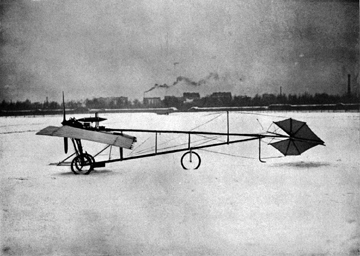

Santos-Dumont is often set forth as an "Aviation First." Brazilians are especially fond of their native son, and often claim he made the "first true flight." Even the First Flight Society's shrine at Kitty Hawk, which has inducted Santos-Dumont into its hall of fame, claims he was the "First to fly a heavier-than-air machine in Europe" and that he was the "Third man in all the world to fly a powered aircraft."
This is madness. Such claims are only true when you express the proper qualifications. Clement Ader certainly took some sort of a hop through the air in a powered craft long before Santos-Dumont. I think it quite likely that Richard Pearse made a flight long before Santos-Dumont as well. What about Maxim? If you don't like Maxim, how about Herring or Whitehead?
Such claims speak more about our need to count things than provide any interesting illumination of the history of the airplane.
Let us briefly consider the claims that Santos-Dumont was the first to "build and fly an aircraft 'heavier-than-the-air' by means of its own propulsion" and that "Indeed, that primordial dream of Man - to fly free as a bird - was made reality on that day, by the hands of the Brazilian Santos-Dumont." These claims are based on such a stretching of historical fact the truth can hardly be recognized.
The claim is based on disqualifying the flights made by the Wrights because "The airplane didn't take off under its own power." The Wrights developed a catapult system in 1904 that was used to launch their airplanes. This system was used for many years. But they didn't use a catapult in 1903 and took off from level ground. Many of their machines, including the 1905 model, could have taken off under their own power. All the Wrights needed to do was to add wheels to their craft and have reasonably-level ground for takeoffs. However, the Wrights didn't care to have their machine damaged in takeoff from soft fields, and so employed an efficient, reliable, and elegant means of launching their craft. To claim this disqualifies their craft as airplanes is taking a minor matter far too seriously. To ignore the performance of the 1903 craft is absurd.
By the way, others not only had their airplanes damaged during takeoff using wheels, some people were even killed when the plane hit a rut during takeoff. In comparison, the Wright's catapult system was, like most other features of the Wright airplane, a beautiful and efficient solution to a difficult problem.
Compare the flight of Santos-Dumont's 14-Bis with one of the Wright's European flights. Which plane do YOU think is flying?
Santos-Dumont later went on to develop a monoplane design, the Demoiselle, which was a much more influential craft than the 14-Bis.

The Brazilians are proud of the accomplishments of Santos-Dumont, and have every right to be. He certainly played a role in the development of effective monoplanes, popularized both dirigible flight and helped the development of heavier-than-air craft. But celebrate him for what he did, not for what you WISH he did. It is very tiresome to see people champion their favorite cause at the expense of the Wrights.